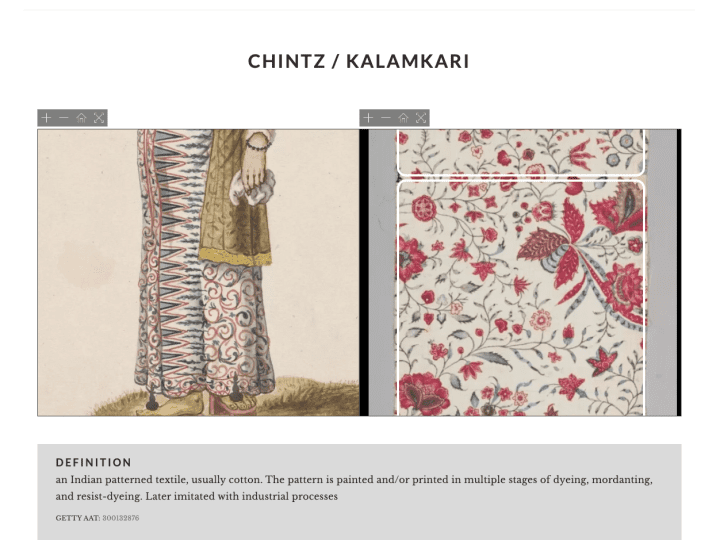What started with a grant from the Gladys Krieble Delmas Foundation to integrate the Dutch Textile Trade Project into the JHNA publishing platform grew into a broader digital art historical project. Strengthened by a grant from the Samuel H. Kress Foundation to redesign and enrich the Dutch Textile Trade Project site while creating additional technical functionality for JHNA, the results benefit not only this textiles-focused issue but also future JHNA authors and readers alike.
Introduction
Initially, authors Carrie Anderson and Marsely Kehoe partnered with me to brainstorm ways of bringing to life a visual resource for the Dutch Textile Trade Project, which then consisted of a prototype built in Omeka with a handful of case studies and a large data set related to the early modern textile trade.1 These data were amassed from the cargo documentation of the Dutch East and West India Companies (VOC and WIC), from which Anderson and Kehoe had pulled information about specific textiles, including their prices, quantities, origins, destinations, and visual characteristics. Anderson and Kehoe proposed to integrate these data alongside material and visual examples. Given the complexity of these data and their value to a broad range of scholars including art historians, textile historians, economic historians, and data humanists, but also non-specialists, Anderson and Kehoe were committed to making their work accessible in a digital space. With a generous grant from the Gladys Krieble Delmas Foundation, they secured the initial support needed to begin developing critical digital components of the project.
The digital tools offered by JHNA were a natural fit for the Dutch Textile Trade Project. In 2019, JHNA developed an image comparison and multi-modal viewer that enabled authors to display content-related image comparisons, which could also be independently explored by end users.2 The multi-modal image viewer utilizes International Image Interoperability Framework (IIIF, or “triple eye eff”) images, which allow users to compare, zoom, and explore images in high resolution. An additional enhancement, in 2020, incorporated image annotation into the suite of tools, which allows users to zoom, pan, and compare in a layered or synchronous viewing experience alongside author narratives.
Since The Dutch Textile Trade Project is an ongoing project, Anderson and Kehoe planned to create a standalone platform outside of JHNA, which would take advantage of the existing enhancements within the JHNA site. In addition, the project team would integrate a controlled vocabulary (discussed below), a new enhancement that would be implemented in JHNA’s site and also in the Dutch Textile Trade Project’s Visual Glossary.
Meeting on a regular basis, we created general requirements for a separate site that would:
- Ensure the data would be persistently available and flexible for future use;
- Provide an easily accessible platform for the Visual Textile Glossary; and
- Allow for contextualization of these textile terms with text, multi-modal image comparisons, and interactive data visualizations.
Using these requirements as its lodestar, Anderson and Kehoe were awarded a Digital Art History Grant from the Samuel H. Kress Foundation in part to continue building a stand-alone site for the Visual Textile Glossary and in part to hire a postdoctoral fellow to help transcribe additional data from the West India Company archives. They were awarded a second grant for the project from the Foundation in fall 2022.
Dutch Textile Trade Project Site
The Dutch Textile Trade Project grew from Anderson and Kehoe’s desire to learn more about the representation of textiles in early modern images, and their recognition that Dutch archives contain ample data related to the textile trade, as discussed in their lead article in this issue. While these documents have been examined by many scholars, they saw the potential of bringing digital humanities methods to bear on some of the challenges of understanding trade textiles, which include shifting markets, inconsistent terminology, and conflicting primary and secondary sources definitions. Connecting these data to visual and material culture offered a further interpretive lens. To demonstrate the richness of these archival data and their potential interpretive value, Anderson and Kehoe spent several years amassing the initial data offering, from multiple sources. They wanted to turn this information into a resource that would help answer their own research questions and would also advance the research of a larger interdisciplinary academic community.
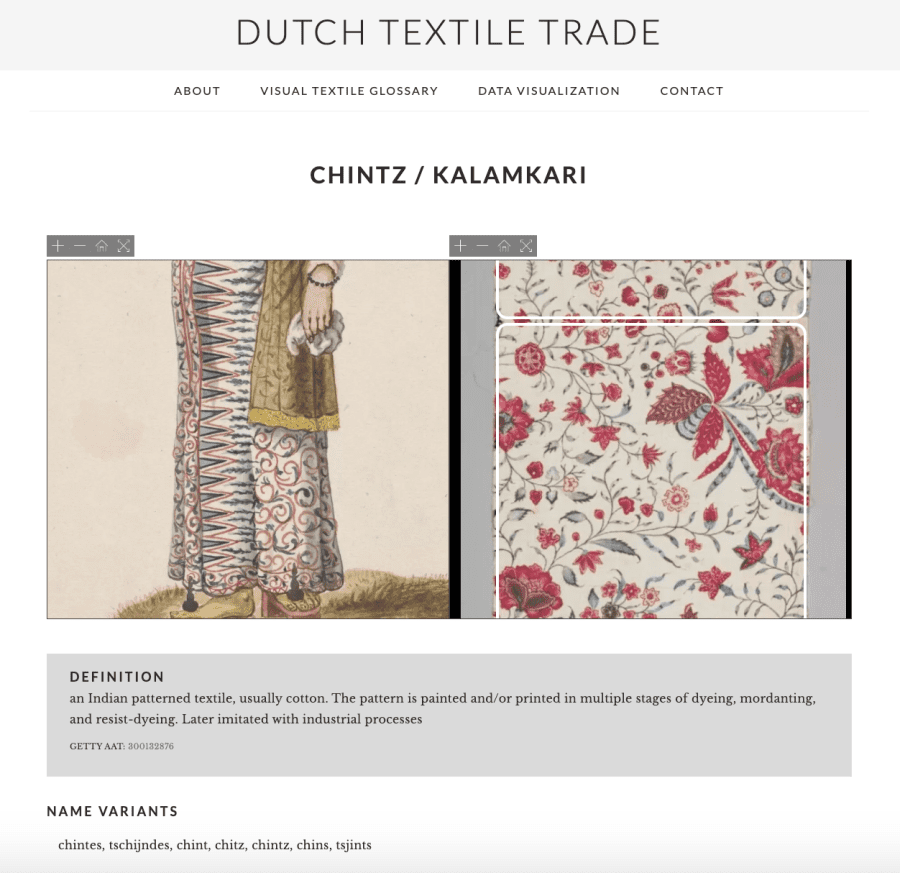
Anderson and Kehoe worked with developer Morgan Schwartz and me to develop an effective framework for linking historical textile terms with early modern images of textiles, utilizing some of the tools initially developed for the JHNA platform. The final format provides the textile term above a side-by-side image comparison, which is equipped with annotations (fig. 1). The definition for the textile name then appears below, followed by an expository essay, which expands on the economic, material, and historical context of its production, contextualizing each textile in historical trade, economic, and artistic information. Each entry in the Visual Textile Glossary also considers how a given textile may have generated meaning when represented in paintings, prints, and drawings. Related images enable users to explore additional contexts for these textiles, including (where possible) an IIIF manifest to perform independent image comparison using an IIIF viewer such as Mirador.
A critical turning point for the project occurred in January 2021, when Anderson had the opportunity to co-teach the first of two iterations of a course at Middlebury College called “Data Science Across Disciplines,” which was supported by the MiddData initiative. In this course, students learned the programming language R from Middlebury College Mathematics Professor Alex Lyford, which they employed to make data visualizations and interactive web applications for their textile data set using the R package Shiny.3 These interactive web applications allow for end user-directed exploration of their accumulated data, making it accessible to scholars with different textile-related research questions. The exemplary work of these undergraduate Middlebury students, coupled with a massive data normalization effort by Kehoe, Anderson, and the project’s Kress-supported postdoctoral scholar, Talitha Schepers, resulted in the development of two data visualization apps, which are embedded in the site to facilitate the exploration of textile movement geographically and textile types and subtypes through geography and value (fig. 2). For users who wish to interrogate the data independently of the applications, the raw data is available for download.
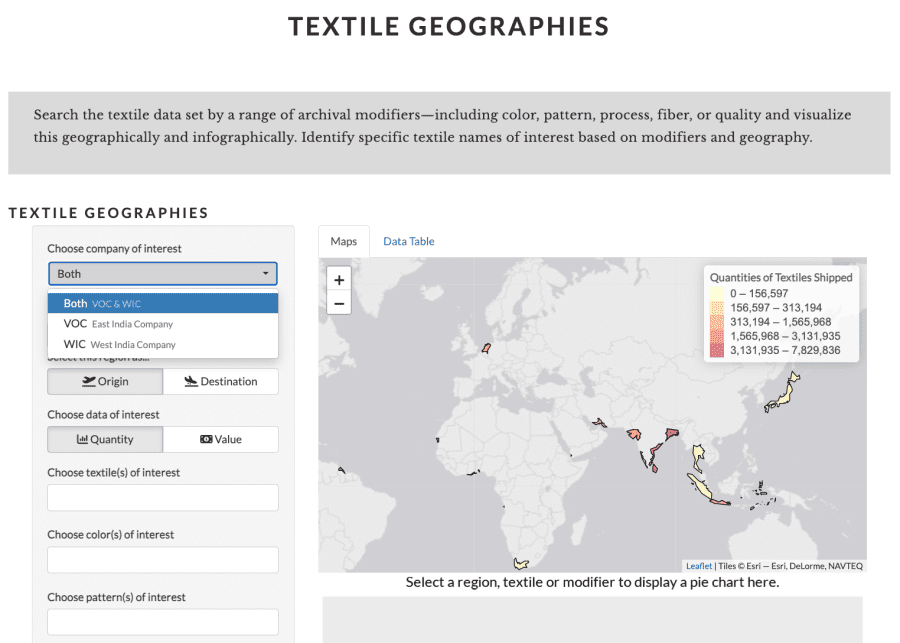
Recognizing the importance of building a common vocabulary for the study of historic trade textiles, Anderson and Kehoe centered the site around a visual glossary of textile terms. Controlled vocabularies add consistency to how subjects are spelled, and a formal taxonomy or hierarchical structure offers context for better understanding where a term resides in a category or subcategory (see Henel’s essay in this issue). The Getty Art & Architecture Thesaurus (AAT) offered an appropriate source for these textile terms. Anderson and Kehoe have offered up the initial published textile terms, definitions, and name variants from historical sources for long-term management by the Getty, and in exchange there is now a consistent and broadly accessible way of referring to textiles identified by the project (fig. 3).4 This is the start of a longer contribution to the AAT, which will grow as new terms are added to the visual glossary. Further, the Dutch Textile Trade Project’s visual glossary entries display the name variants with qualifiers, as well as the unique identifier for the term within the AAT for seamless integration.
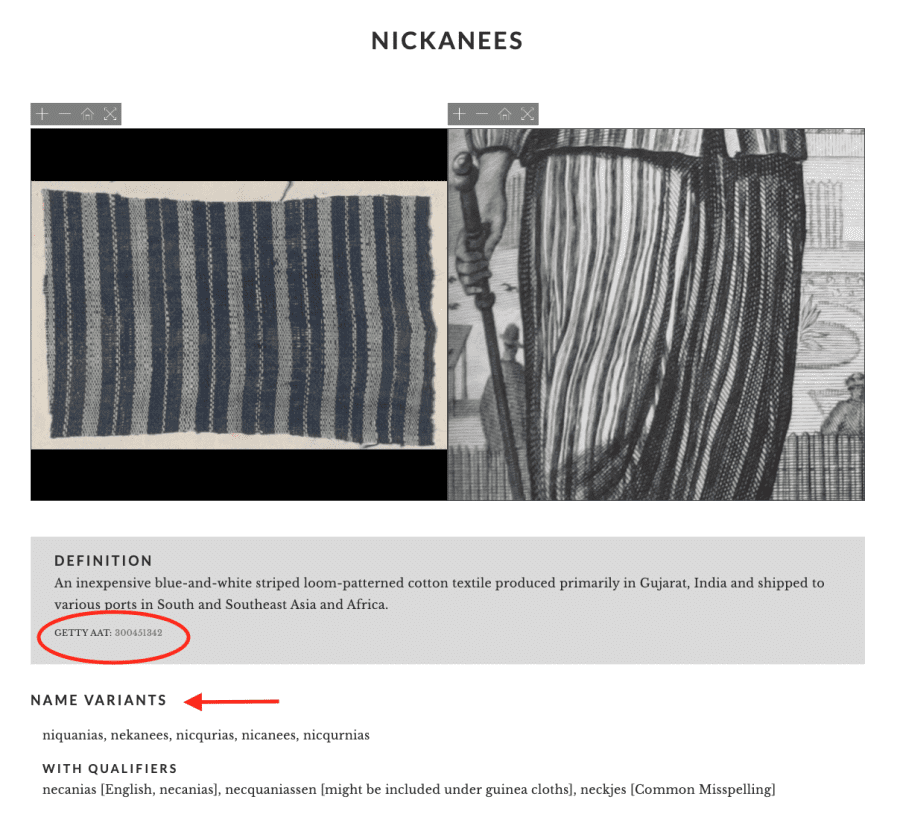
JHNA Enhancements
In considering ways in which this project could enhance JHNA’s digital toolkit, we sought a repeatable development. JHNA also chose to integrate the AAT to begin building formal connections to article keywords. Since JHNA’s inception, keywords have been used to aid in article discoverability. Each author generates keywords which until now have not conformed to a standard vocabulary or taxonomy. Using the Dutch Textile Trade Project as a catalyst, JHNA can now integrate the AAT unique identifier with the keywords (fig. 4). The benefit is a repeatable, consistent, and more sustainable way of describing its contents and increasing discoverability of the texts to a broader audience.

JHNA is also integrating an embedded site viewer to actively use the data provided by the Dutch Textile Trade Project in situ, affording users immediate access to the data discussed while maintaining their location in the text (fig. 5).
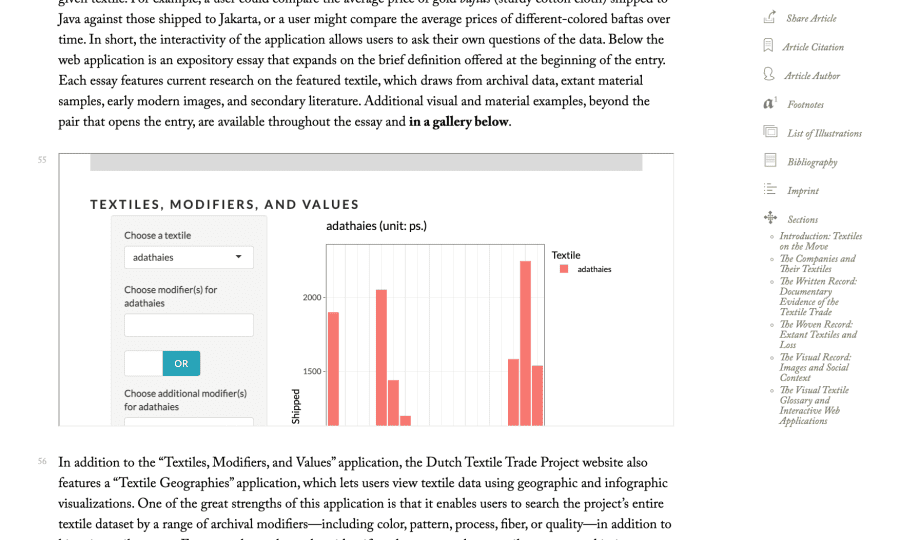
For example the apps developed in Shiny are now available within the context of the essay for independent exploration. Using iFrame, future JHNA articles can render data sources for other digitally-sourced efforts from its authors.
Conclusion
This issue celebrates new and exciting ways of exploring traditional information. Essays in this Special Issue reflect not only historical scholarship, but also the ways in which digital art history expands the audience and information aperture. Enhancing JHNA to include controlled, standardized vocabularies broadens the readership, just as developments to the image IIIF annotation model present new opportunities for current and future authors to share their discoveries. As a born-digital publication, JHNA continues to showcase the potential of this medium. The launch of the Dutch Textile Trade Project marks this moment and serves as a starting point for future scholarship.
